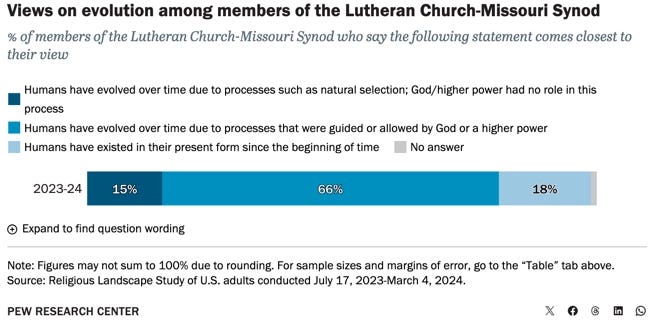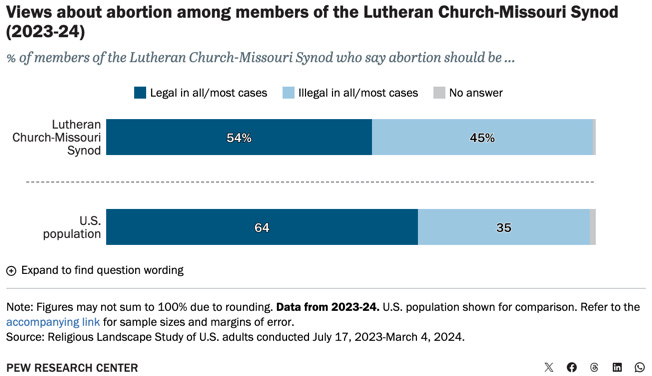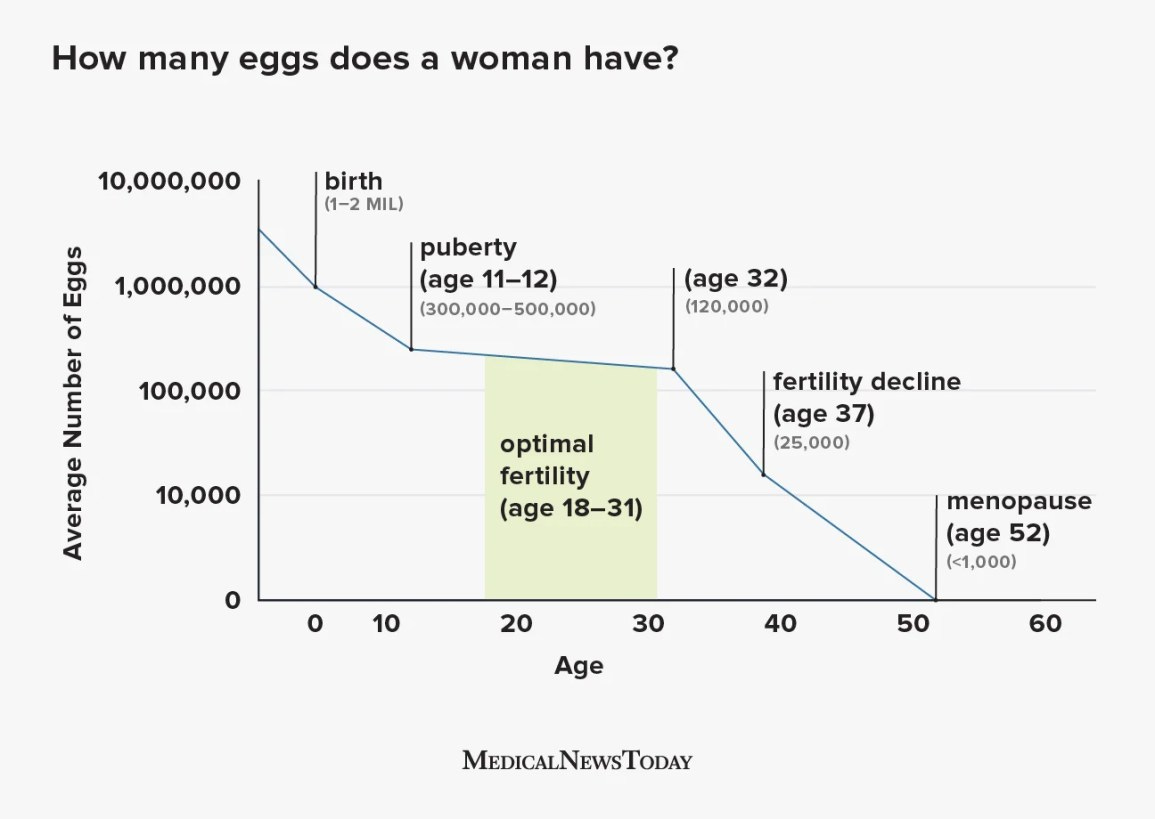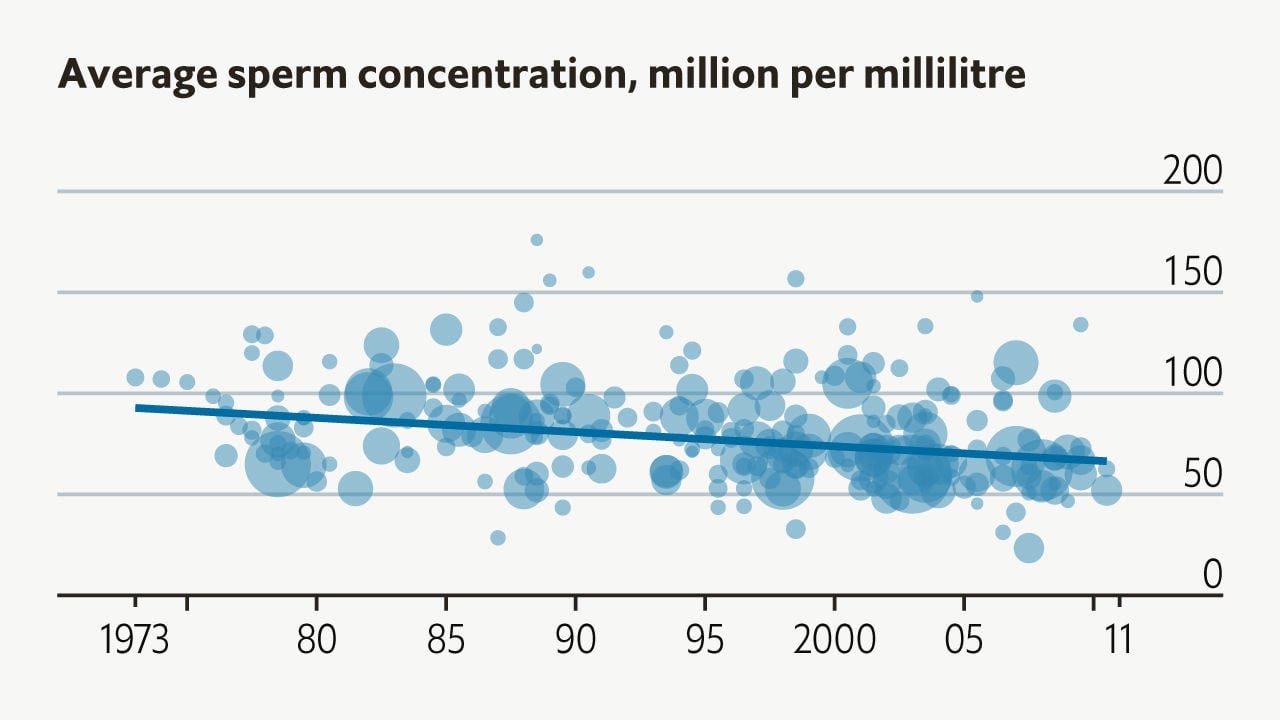Must the LCMS Accept Its Orderly Extinction?
If the LCMS continues on its current demographic trajectory, it will cease to exist before the end of this century, but there is hope if we look at the young families.
We are on the cusp of concluding two millennia since Christ’s death, resurrection, and ascension in AD 33, so it is fitting to consider the future of the LCMS. Three big questions come to mind as we consider the grim reality that the Synod will probably record weekly attendance falling by two-thirds in a single generation (30 years) by 2030.
On the current trajectory, how many years will it take for LCMS weekly attendance to fall below 50,000? At that point, the Synod will have ceased to exist functionally for a long time.
Making some assumptions about a fertility-driven recovery, how long will it take to return to 1,000,0000 weekly worship attendees?
Without a fertility-driven recovery, how many converts are required to sustain weekly attendance above 300,000 after 2030?
Let’s try to answer it, starting with some Synod data points focusing on the last 19 years and then a thumbsketch analysis.
Caveat: what happens is God’s will, but Scripture is clear that in our sanctification, we are not passive about the present and the future. Similarly, God did not ordain the LCMS, but we will be worse off for its demise because healthy institutions are important even for Christians. Accelerationists will disagree, and perhaps you can sympathize with their concerns, but the alternative of several dozen micro-synods is nothing to look forward to.
Onward to less kvetching and more rehabilitation! Meanwhile, the prayers of the righteous availeth much.
It would be much more helpful if the annual report data included weighted averages and medians rather than aggregate numbers. Nevertheless, let’s work with what we have from the publicly available data, including this invaluable package from Synod.
The static number of active pastors and the relative stability of parishes are notable and surprising. Consequently, the Synod is becoming increasingly top-heavy and resembles Social Security’s instability, where fewer contributors are propping up more beneficiaries. This is apparent in the pressure on clergy wages and benefits as declining parishes struggle to maintain and match inflation for their pastor’s compensation packages. In the near term, the oversupply of pastors relative to the undersupply of parishioners cannot be wished away.
Weekly attendance is the most critical metric for the Synod, Districts, and congregations. Weekly attendees, especially those managing at least 75% of services, are the foundation of everything in your parish. They contribute the money, time, and effort to sustain and build congregations.
Alarmingly, the ratio of members achieving regular attendance has gone into an accelerated decline. Churches that promoted virtual worship and Holy Communion during COVID-19 will suffer the most because they catechized their members out of attendance. That said, it is probably more realistic that “dormant” members are kept on the rolls long after they quit attending church. So, we must focus on attendance more than anything else at this point.
Model Assumptions.
WELS and ELS continue to reject fellowship and potential union.
Adoption is not a measurable source of growth.
Initial Weekly Attendance (2023):
Total: 418,150 (Discounted 20% from reported figures to account for record-keeping errors and transfer lag).
Confessional Cohort (65%): 271,798. The distribution favoring Confessionals is driven by anecdotal observation of attendance habits.
Liberal Cohort (35%): 146,352.
Age Distribution (2023):
Overall average: ~53 years.
Confessional cohort: ~40 years (reflecting a younger influx).
Liberal cohort: ~63 years (older demographic).
Fertility Rates:
The Synod’s Confessional and Liberal Cohorts have widely divergent views on social and political issues, manifesting in each cohort's fertility rates.1 The divide mirrors national trends, but the Synod’s Liberal cohort is older than the Confessional cohort, which has profound implications for its future.
Source: Ryan Burge on X Based on the data below, it is possible that the Confessional cohort is being overestimated, given how much of the Synod has apostatized. That said, be alert to push-polling manipulations and efforts to demoralize Christians (to understand designed demoralization, see Desecrating our Sacred Spaces).

Source: Pew Research 
Source: Pew Research 
Source: Pew Research Confessional Cohort:
Starts at TFR 2.3 in 2023.
Increases linearly to 3.4 by 2043 (20 years; +0.055/year). Historical US TFR was as high as 7.0 in 1800 and recovered to over 3.5 for the post-war Baby Boom.
Declines linearly to 2.8 by 2063 (20 more years; -0.03/year).
Stabilizes at 2.8 post-2063.
Initial fertile women: 67,950 (50% of 271,798, 50% fertile), evolving as the prior cohort ages out and daughters replace them.
Liberal Cohort:
Starts at TFR 1.5 in 2023.
Declines linearly to 1.3 by 2060 (37 years; -0.0054/year).
Stabilizes at 1.3 post 2060.
Initial fertile women: 36,588 (50% of 146,352, 50% fertile), shrinking due to low TFR and low retention of children.
Child Retention (Percentage Remaining in Synod After Age 17):
Confessional: 66% (constant; children join ~17 years after birth).
Liberal: Starts at 40% in 2023, declines linearly to 10% by 2063 (40 years; -0.75%/year), stabilizes at 10% thereafter.
Conversions:
Rate: 0.1% per year applied to the previous decade’s total attendance.
Distribution:
Until 2040: 65% to confessional, 35% to liberal.
Post-2040: 100% to confessional cohort.
Decline Rate:
Base rate: -3.5% in 2023–2024.
Acceleration: +0.15% per year (e.g., -4.45% by 2030, -5.95% by 2040, -15.05% by 2100).
Applied to the 2023 base attendance (271,798 confessional, 146,352 liberal) each decade, diminishing as a factor as retained children and conversions dominate growth.
Population Dynamics:
Fertile women:
Confessional: Initial 67,950 replaced by daughters of prior cohorts (e.g., ~43,013 by 2043, adjusted for TFR and retention).
Liberal: Initial 36,588 declines (e.g., ~220 by 2100) due to TFR < 2.1 and low retention.
Children born per year are calculated as: (fertile women × TFR) ÷ 20 (assuming a 20-year fertile period).
This simple model assumes no external shocks (e.g., pandemics, schisms, wars, natural disasters, revivals, etc.) beyond the initial decline trend and relies on anecdotal evidence for the confessional cohort’s fertility and retention to reverse the historical downturn observed from 1990 to 2023.
Since I don’t know an integer from a treble clef, Grok’s more accomplished math brain was tasked with building the models to generate the following results.
Question 1
On the current trajectory, how many years will it take for LCMS weekly attendance to fall below 50,000?
Compound annual decline rates:
1990-2000: -0.1% per year, relatively stable.
2000–2010: -1.64% per year, reflecting pre-recession stability compared with prior years.
2010–2020: -3.35% per year. The decline accelerated in 2020, probably due to heavy COVID-19 attrition due to closures, social distancing, and related conflicts.
2020–2023: -7.85% per year. This is probably due to the fallout from COVID-19, as many parishioners fail to return to church for various reasons.
Overall 1990–2023: -2.27% (long-term average).
It seems reasonable to use a combination of long-term declines with some consideration of the spikes for a long-term base rate of decline of -3.5% per year with +0.15% per year acceleration. On this basis, the LCMS falls below 50,000 average weekly worshippers between 2070 and 2080.
Decline Rate: -4.38% CAGR (compound annual growth rate) from 2010–2023 is sustained, reflecting the accelerated trend post-2010 (-3.35% to -7.85%).
No Stabilization: no fertility-driven growth, and both cohorts decline proportionally at -4.38%/year.
Result: Total attendance falls below 50,000 by 2080 (43,906) and nears extinction by 2100 (18,504).
Question 2
Making some assumptions about a demographic inflection, how long will it take to return to 1,000,0000 weekly worship attendees?
The Synod could stabilize and grow if we apply a demographic stabilization effect with TFR-driven growth in the Confessional cohort and with all the model assumptions listed above, which we believe are reasonable to slightly conservative.
Using this TFR-driven growth model, the LCMS could return to 1 million weekly attendees by 2131. In other words, the best way to make Christians is to conceive Christians.
Accelerating the confessional TFR from 2.3 to 3.1 over 10 years (by 2033) obviously enhances growth more than the 20-year (2043) model, increasing the 2100 total to 677,109 from 642,444 (20-year), a ~5.4% gain driven by earlier and higher fertility contributions. If peak TFR can be advanced by one decade, the Synod could return to 1 million attendees 4 years earlier in 2127.
A more conservative model
What happens if we tweak the model to have lower assumptions?
Confessional Cohort share is only 55% of the total rather than 65%
TFR peaks at 2.8 rather than 3.4, but peaks earlier.
Child retention is only 60% instead of 66%.
The Confessional cohort average age was 45 in 2023 rather than 40.
Results
Time to 1 Million: From 2023, it takes 182 years (2205 - 2023), significantly longer than prior models (e.g., 2127 with TFR 3.4 by 2033, 66% retention, 55% confessional share).
Growth Dynamics: Lower TFR peak (2.8 vs. 3.4), reduced retention (60% vs. 66%), smaller confessional share (55% vs. 65%), and older starting age (45 vs. 40) slow growth, delaying recovery to 1 million by ~78 years compared to the TFR 3.4-by-2033 model.
Confessional Dominance: Still drives growth (e.g., 928,454 by 2210), but at a reduced pace due to lower demographic inputs.
Liberal Stability: Levels off at ~96,000, minimally impacted by changes.
Question 3
Without a fertility-driven recovery, how many converts are required to sustain weekly attendance above 300,000 after 2030?
Under the current -4.38% CAGR trajectory (excludes all the assumptions) and without a fertility-driven turnaround, the Synod would need approximately 693,428 converts over 70 years, averaging 9,906 converts per year. This begins with 54,428 converts in 2040 (to offset the drop below 300,000) and 106,500 per decade from 2050–2100, reflecting the relentless decline without demographic stabilization.
Stabilization through evangelism alone is impossible without a miracle. The LCMS has never achieved conversion rates approaching those levels, and successive waves of German and Scandinavian immigration drove its previous geometric growth. Evangelistic growth can be significant, but it is trivial compared to increased fertility's potential impact.
What must change?
The recent rapid and accelerating decline in membership and attendance is a rolling catastrophe for the LCMS. A combination of factors is to blame, but there is no mystery about what happens when your church body loses two-thirds of its weekly attendees in just three decades. Depopulation is nothing less than an atomic bomb for Christians. As we see worldwide, demographic decline is easy to incentivize and set in motion, but it is extraordinarily difficult to reverse once it sets in. It’s far more effective in the long term than persecution and suppression because we bring about our own demise.
The Synod should have gone into an overdrive corrective posture from 2000 to 2010 as the collapse onset, especially to identify where, when, and how the bomb was conceived in the 1980s and manufactured in the 1990s. From 2000 to 2010, the fallout that we suffer from now was detonated, producing a pronounced negative flywheel effect for the subsequent decades.
Our church body has much to repent of for adopting and adapting to the social mores of the world. Its readiness to exchange fertility for material prosperity is chief among the sins of faithlessness. We are among the condemned with only three children, and we greatly regret decisions that made more children our choice rather than God’s will.
The Synod will go extinct if we do not address the prevailing lackadaisical and anti-Biblical attitude to fecundity. It is very encouraging to see the youngsters with growing and large families, but it is a tragedy, if not forbidden, when our pastors treat children as adiaphora.
A new Synod-wide catechesis about families and children has begun at the parish and conference level, principally through the example of our faithful pastors having many children. Still, it needs to intensify in every area. Scripture is very clear about the value of children and the need for lots of them. Let’s believe, teach, confess, and demonstrate that every day.
Teaching the basics and knowing the situation
Our pastors need to teach even simple things as we look to boost marriage. These days, primarily young men seem to miss taking showers, using deodorant, washing and brushing hair, flossing and brushing teeth, clipping their nails, dressing in more than a T-shirt, shorts, and slides in formal situations, chewing with the mouth closed, looking people in the eye, taking off hats indoors, and having some capacity to start and finish a conversation. Boys, hypergamous gals are not going to fall for your charms if you stink or look like a slob!
As a church body, we cannot encourage marriage and childbearing if we do not also attend to reversing and opposing the deliberate and devastating job theft as well as the cost of living squeeze that has undermined family formation. We wrote about those concerns in the following articles:
We must also be aware of and alert to external social and environmental factors affecting fertility. Here are some things to consider.
Promiscuous culture engendering:
Premature sexualization of children at younger ages through media and public education.
Converting the marriage bed into a recreational activity.
Permissive attitudes to contraception. The medications and devices also disrupt female fertility, spike breast cancer risks, and inhibit breastfeeding by suppressing prolactin secretion.
Increasing tolerance for abortion, including chemical abortions and infanticide through birth.
Promotion of sexual deviancy with attendant social, spiritual (psychological), and health damage. The increase in homosexuality eliminates potential fertile pairings and is simply mass selective sterilization.
Delaying childbearing beyond peak female fertility. Eggs rapidly decline in quantity and quality as women age.
Pursuit of materialism engendering:
Reducing children to fungible units of production and consumption that compete for scarce resources.
Pressure to delay or forgo children to deal with rising costs of living.
Female education and workforce participation correlate with delayed marriage and childbirth, as well as smaller family sizes due to time and resource constraints.
Tolerance for sterilization.
Urbanization and modernization engendering:
Feminism demands greater emphasis on equality and shared responsibilities, which leads couples to prioritize personal goals or dual careers over family formation. Another consequence is the divorce epidemic, with women initiating divorce at alarmingly high rates.
Government and secular factions use social engineering to raise living costs, compress living spaces, and make family formation undesirable if not unattainable.
Social pressure to conform: Large families report encountering hostile reactions in public settings like supermarkets. Society prizes individual fulfillment, “experiential” living, career success, and "quality-over-quantity" family models.
Apocalyptic propaganda about overpopulation exceeding the earth’s resource capacity or amplifying negative “climate change.”
Biological and Environmental Factors:
Sperm counts are declining as testosterone plummets in men. Our environment and food supply are awash in synthetic estrogens or estrogen-mimicking compounds (e.g., from phthalate-contaminated plastics like BPA, pesticides like Endosulfan, herbicides like Atrazine or pharmaceuticals like birth control) that elevate estrogenic activity in men and suppress testicular function. Christians should be on the zealous spectrum of environmental activism to eliminate exogenous estrogens.
Our foods have been recklessly contaminated with compounds that make us obese. Obesity makes men feminine since fat tissue increases aromatase activity that loads them up with estrogen. Men, you are voluntarily transing yourself when you get fat!
There is a cumulative effect from hormonal contraceptives and hormone replacement therapy (HRT) entering water systems via dosed female urination that increases male exposure to exogenous estrogens.
Endocrine disrupters abound, such as per- and polyfluoroalkyl (PFAS), a “forever chemical” that accumulates in humans.
Obesity is just as devastating for female fertility. It stimulates insulin resistance, which increases testosterone levels. That disrupts follicular development and ovulation. Fat tissue also elevates leptin in women, which disrupts menstrual cycles.
Finally, obesity is a killer of marriage satisfaction and happiness. Female fertility windows are surprisingly small, so there are limited opportunities to conceive. The odds of success decline logarithmically with age as the supply of eggs decreases, and more so if the weight piles on. So, you have to make hay while the sun shines, and being fat is not conducive to hay-making in any sense. Similarly, married couples with independent out-of-the-home jobs will experience stress and time constraints that inevitably thwart conception opportunities.
☩TW☩
Home page picture credit: St. John Lutheran Church, Indianapolis, IN
Data from the General Social Survey (GSS), (General Social Survey, 1972–2022 (or specific years analyzed, e.g., 1995–2018), NORC at the University of Chicago) as cited in multiple analyses, provides a detailed look at the difference between Conservative and Liberal women. For women over age 45 surveyed between 1995 and 2018, conservative women had a completed fertility rate of approximately 0.25 children higher than their liberal counterparts after controlling for factors like age, race, education, and marital status. This gap widens among younger women (ages 30-44) in recent years, suggesting a growing divide. For example, posts on X and web analyses referencing GSS data estimate liberal women's TFR at around 1.5 to 1.6 children. In comparison, conservative women's TFR is closer to 2.0 to 2.3 children, yielding a difference of roughly 0.5 to 0.8 children per woman.
Broader studies, such as those from the Institute for Family Studies, reinforce this trend. They note that in the 2000s, completed fertility for liberal women declined markedly below that of conservative women, with the gap potentially increasing further in recent years. Some analyses tied to voting patterns suggest an even larger difference—counties with strong Republican (conservative) support in the 2024 election had TFRs about 0.5 to 0.9 children higher than heavily Democratic (liberal) counties. However, this reflects geographic and cultural factors beyond ideology alone.
See:
* https://www.thecut.com/2012/11/states-conservative-as-their-women-are-fertile.html
* https://www.pnas.org/doi/10.1073/pnas.1918006117
* https://ifstudies.org/blog/the-conservative-fertility-advantage




Thanks for the article. Its intent is to provide some measure of a pathway to the future for the LCMS. And it's honest in stating that the path will not be easy. It's also honest in opining that to reach a stabilized goal of 300,000 in attendance on Sunday through outreach evangelism would take a miracle. The LCMS record in that regard belies our stated belief that we are an "evangelical Lutheran" church body. The mystery is why and how such a church body falters on bringing in new adherents from the outside.
My own research leads me in a different direction. The "confessional cohort" at this time is listed in the article at between 65% and 55%. First, I think that's not the case. I believe it's lower - under 50%. Secondly, and more importantly, the lead indicator on attendance should be where the large attendance is located. That's easy enough to determine. And that number keeps going disproportionately toward the congregations with large worship numbers. Even after the debilitations of COVID which were across the board, Sunday worship attendance is skewed well toward the larger congregation, with over 50% of the Sunday attendees at 15% of the congregations. That's a standout statistic. And a healthy 80% of those congregations are specifically NOT in the "confessional cohort" as it's been described.
Those congregations exhibit first of all variety in worship forms, from "traditional" to "contemporary" on any given Sunday. Secondly, they have programing that is extensive and designed to include a broad variety of people, many of whom are from other or no religious background.
The most recent Concordia Journal speaks to the need for this diversity in form for all congregations. At the same time, the bloggers and professors have already joined the chorus which calls for that diversity of style to be avoided.
What that means to me is that the "confessional cohort" will continue to dwindle and congregations will continue to close. the confessional cohort's chief problem is that many of the congregations shepherded by men in that cohort are not sustainable financially or in compensation. I think you have already pointed that out.
So - why would there not be a strong movement to embrace the large congregations which are diversified in worship offerings as a way to build the strength of the mission and purpose of the LCMS? These are LCMS congregations, after all.
I don't have an answer to that question, but I do know that the confessional cohort is not going to embrace those large congregations at any time soon from anything I've read.
Finally (way too long a response), what we're experiencing hearkens back 475 years to the Adiaphoristic Controversy. The first time, Flacius was backed off from "winning," and the result was and remains the Formula of Concord and its Solid Declaration. This time, the official teaching of the denomination at one seminary and maybe both sides with Flacius. And an entire blog-wing filled with clergy has as its motto that the proper form of the liturgy is not an adiaphoron, in complete opposition to the very words of the Formula and Solid Declaration. If the Flacians have there way, the lower numbers you provide in your careful estimations will come to pass.
A bigger issue than procreation is retention. You assume very high retention rates, but from what I've seen our retention rates are closer to 30%, and I think that's the retention post-confirmation. Retention after baptism would be even lower. Growth has always been a result of natural growth, so we can't evangelize ourselves out of this mess, I agree. But just having more babies is only one step, and in many ways increasing our retention would be far more impactful. The Amish have an 85% retention rate along with a high birth rate of about 6 births per woman, and their numbers double every 20-30 years. So we've gotta shoot for improving the birthrate and the retention rate, and I suspect that both of those will go hand in hand.